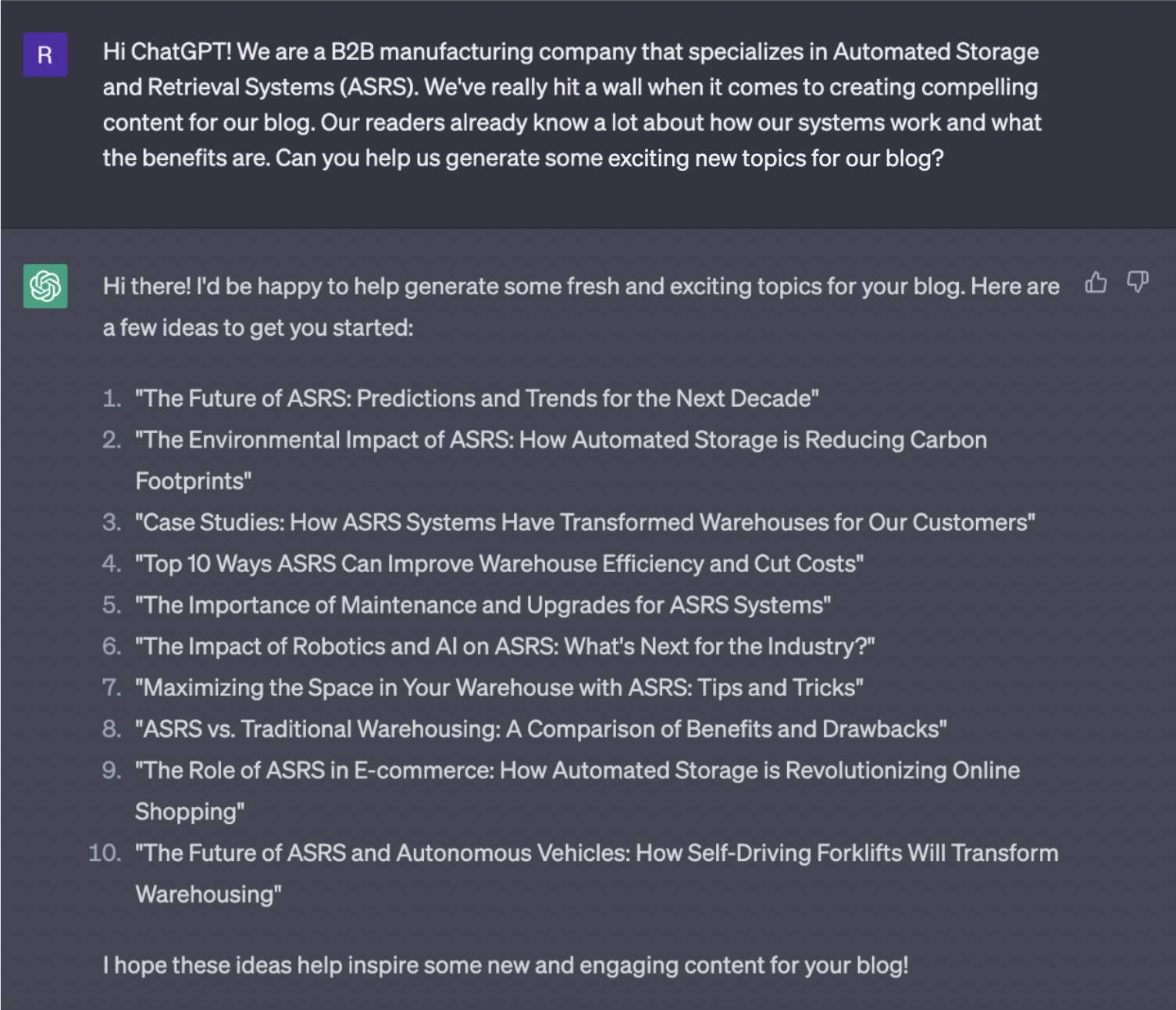ChatGPT. What started as a buzzword on social media has rapidly infiltrated the hearts and minds of B2B businesses around the world.
If you’re a B2B marketer, you’ve likely already felt the draw to this incredible AI tool. Not only is it free and easy to engage with, but the content is - often - very, very good.
And, like so many B2B marketers, you may be wondering:
- Do I really need to use writers anymore?
- Can I simply use ChatGPT to write my copy for me?
- Will I even have a job in six months?
You’re not alone in wondering these things. That’s why we sent one of our team members into the depths of the machine to find out if it really works, if it can create content that ranks, and all the tips and tricks you need to know before you implement ChatGPT for your business.
Let’s dive in.
Table of Contents
Use the links below to jump to the section you're most interested in learning about:
- What is ChatGPT?
- How to Use ChatGPT for B2B Content
- Will my ChatGPT Content Rank in Google?
- What are the Business Risks of Using ChatGPT for B2B Content?
What is ChatGPT?
ChatGPT is an advanced artificial intelligence language model that has the ability to generate human-like responses to a wide range of prompts and questions.
Seriously, you can ask this tool anything.
ChatGPT has exploded on blogs, forums, and social media sites as many businesses in the B2B marketing space begin to leverage it to generate fast and easy content for their target audience.
But ChatGPT doesn’t just write copy. Oh, no.
This language model’s capabilities include:
- Identifying relevant topics and keywords
- Generating high-quality blog content
- Optimizing content for search engines and social media
- And so much more
Simply type a question about your target audience into the tool. We are certain you’ll be surprised by the results.
So it’s easy to see why more and more B2B businesses are turning to ChatGPT to save time and resources to create copy.
But, like many things - the power and ease of this tool can be too good to be true. And that’s why we’re here. To help you understand the areas where ChatGPT can help - and even possibly hurt - the future of your marketing.
Let’s start with the good stuff.
How to Use ChatGPT for B2B Marketing Strategy
Like we said, there are many powerful ways to utilize ChatGPT as part of your B2B marketing strategy. As a B2B marketing agency, we are really excited to help our team and clients thoughtfully implement ChatGPT within their organization.
Here are just a few ways folks are starting to use ChatGPT to scale their marketing efforts:
1. Use ChatGPT to brainstorm new content topics
We’ve all been there. After years of generating copy about similar topics, it can be difficult to know where to go next. ChatGPT can take some of the heavy-lifting off your plate by suggesting topics, keywords, and copy titles that are most interesting to your core audience.
For example, let’s say you’re a manufacturing company that specializes in ASRS. With some simple guidelines, you can generate a list of ten blog topic ideas in just a few seconds:
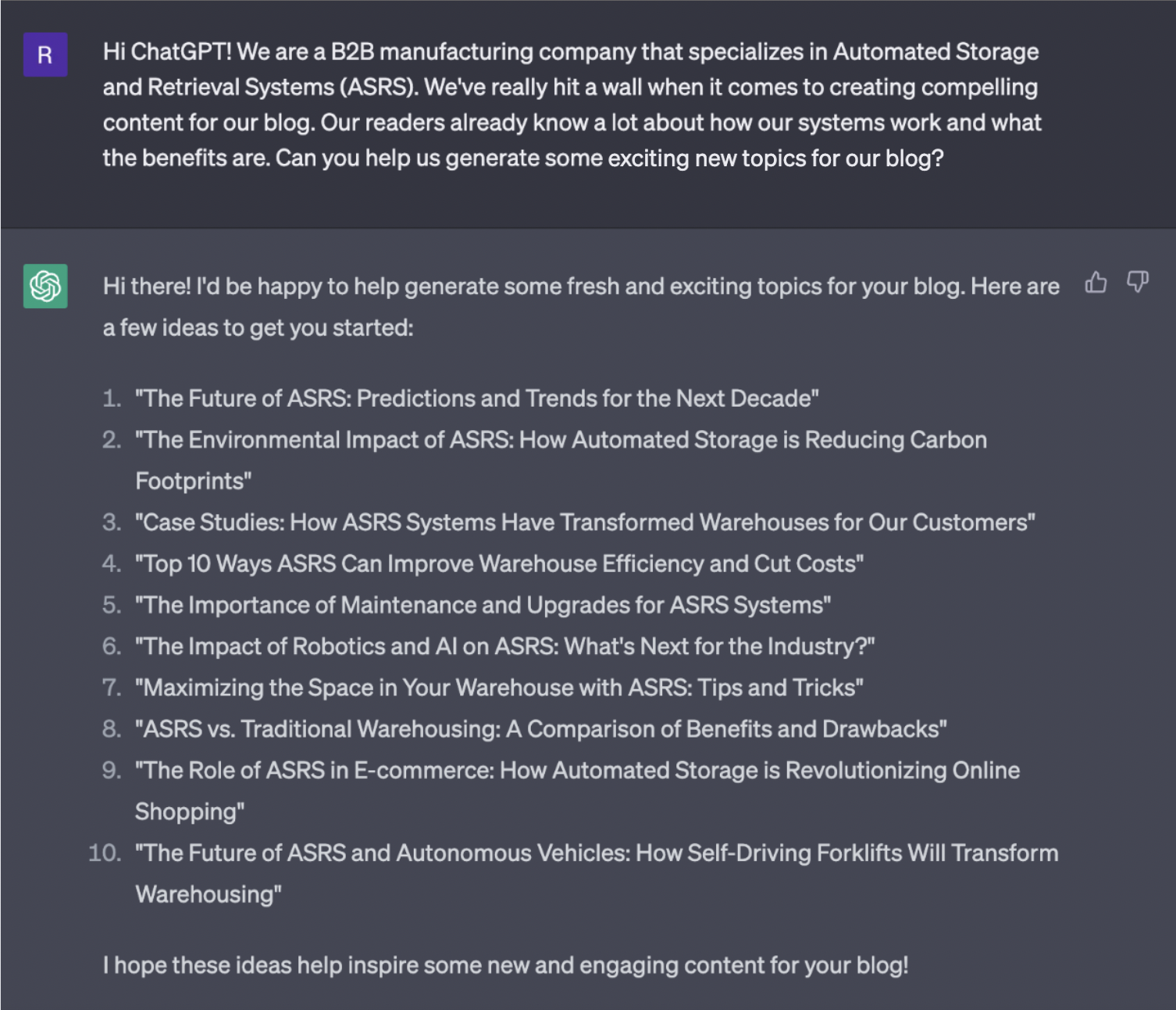
As you can see, some of these topics are… Well… Pretty darn good.
2. Use ChatGPT to write article outlines
If you have a topic you want to explore in more detail, but aren’t sure where to start your research, ChatGPT is here to help. Simply plug in some details about what you want to accomplish with your article, and ChatGPT will put together a compelling outline for you to get started.
In fact, by using the same conversation thread, you can get closer and closer to an end product without needing to re-feed details about your audience or goals into the system.
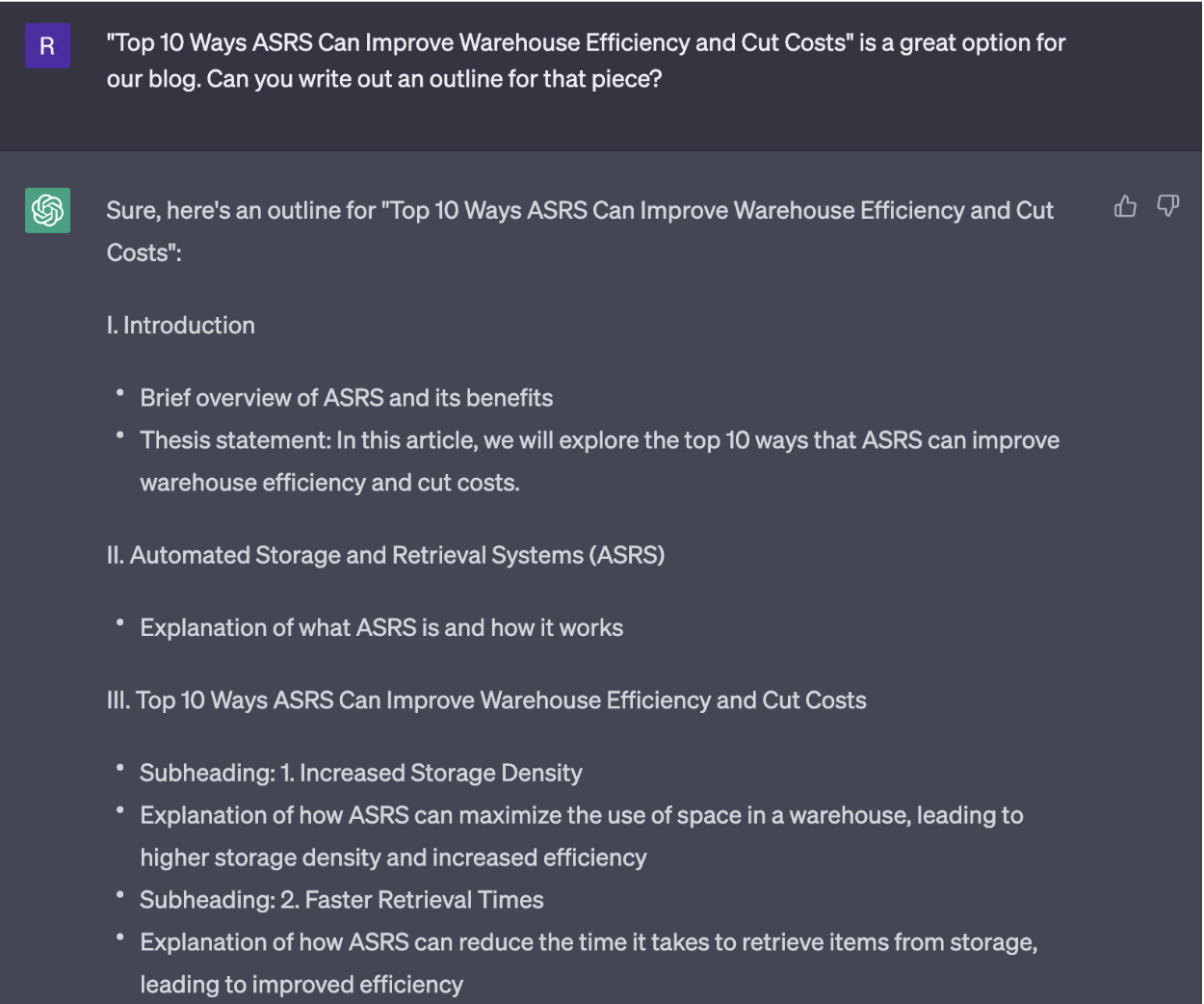
3. Use chatGPT to write copy
But you don’t have to stop there! Once your outline is finalized, you can utilize ChatGPT to fill in body copy for key paragraphs with just a few more prompts.
But the power of the tool doesn’t just stop with article copy. The tool also knows best practices for social media, email nurtures, newsletters, and so much more. So you can easily recycle your content into promotional items with just a few more queries.
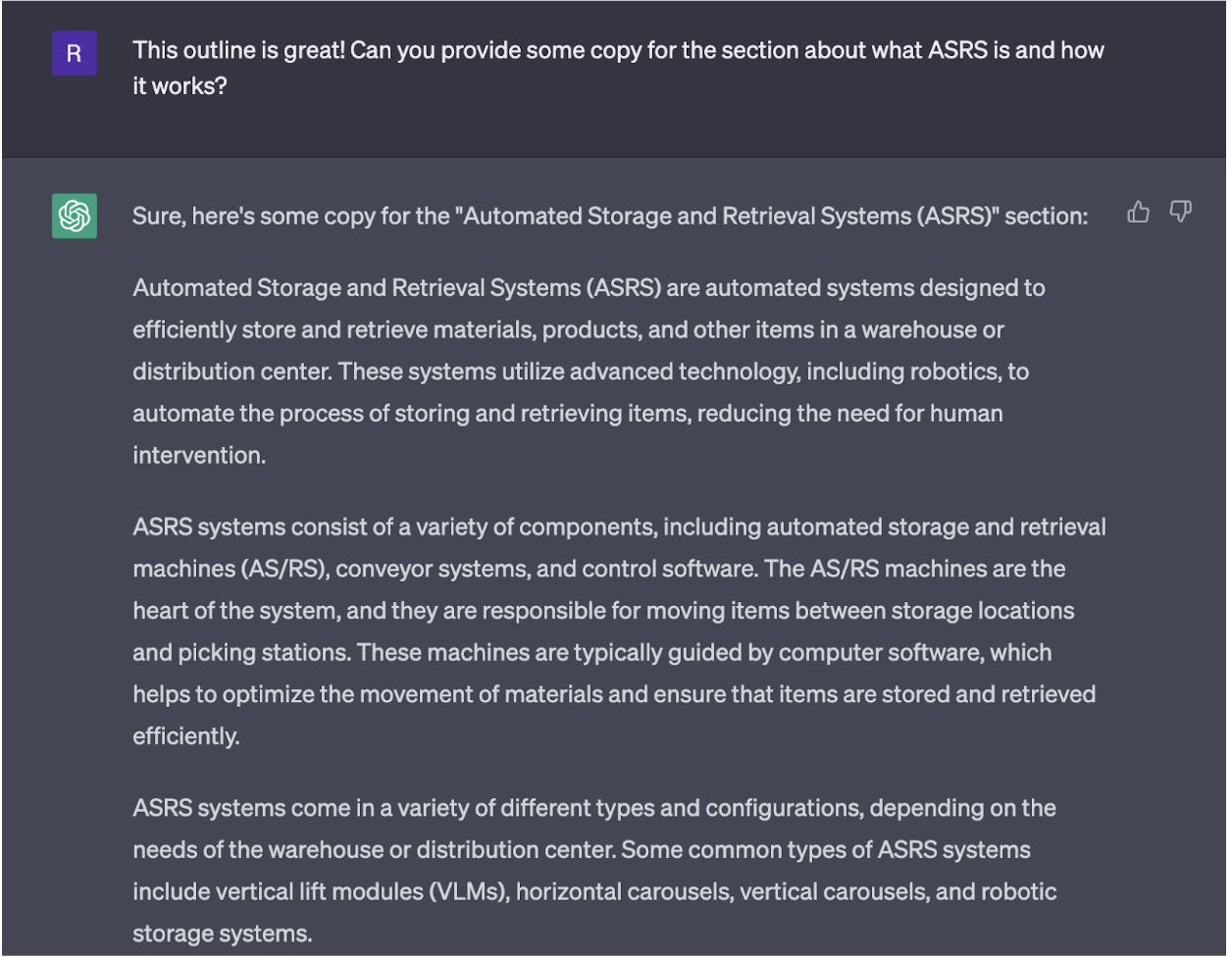
Tips on customizing ChatGPT content to your company’s voice
Your copy doesn’t have to look and sound like a robot. Does your business use a fun and light-hearted voice? You can ask ChatGPT to use that language. Are you a team of finance professionals? No problem. Ask ChatGPT to keep it professional.
No matter your company’s voice, you can easily program it into the AI with simple prompts. We’ll talk more about training ChatGPT next.
There are a few best practices when it comes to training ChatGPT to speak like your business. Here are some best practice tips:
- Always provide relevant input: The more detail you can provide, the better. Don’t just ask it a question. Help the system understand what your business does. Who are you trying to target with your copy? What is their job title? What do they care about? What knowledge do they have already, and where are the gaps? What does your company voice sound like? You can detail all of this in a prompt to generate more thoughtful and targeted responses from the tool.
- Experiment with the tool’s parameters: Did you know that you can also customize the parameters of ChatGPT’s responses? It’s true! The parameters of the tool include the length of the response, the number of results it generates, and the relevance/randomness of the responses it generates. Simply inform the tool what the parameters of your response are and adjust accordingly.
- Give it some feedback: Like any employee, the tool will perform better over time - as long as you give it consistent and helpful feedback. Seriously. You can tell the tool feedback in real time and ask it to adjust. You can also give ‘quick’ feedback by using the like/dislike buttons next to each response. But the best results will come from feeding feedback directly into the AI.
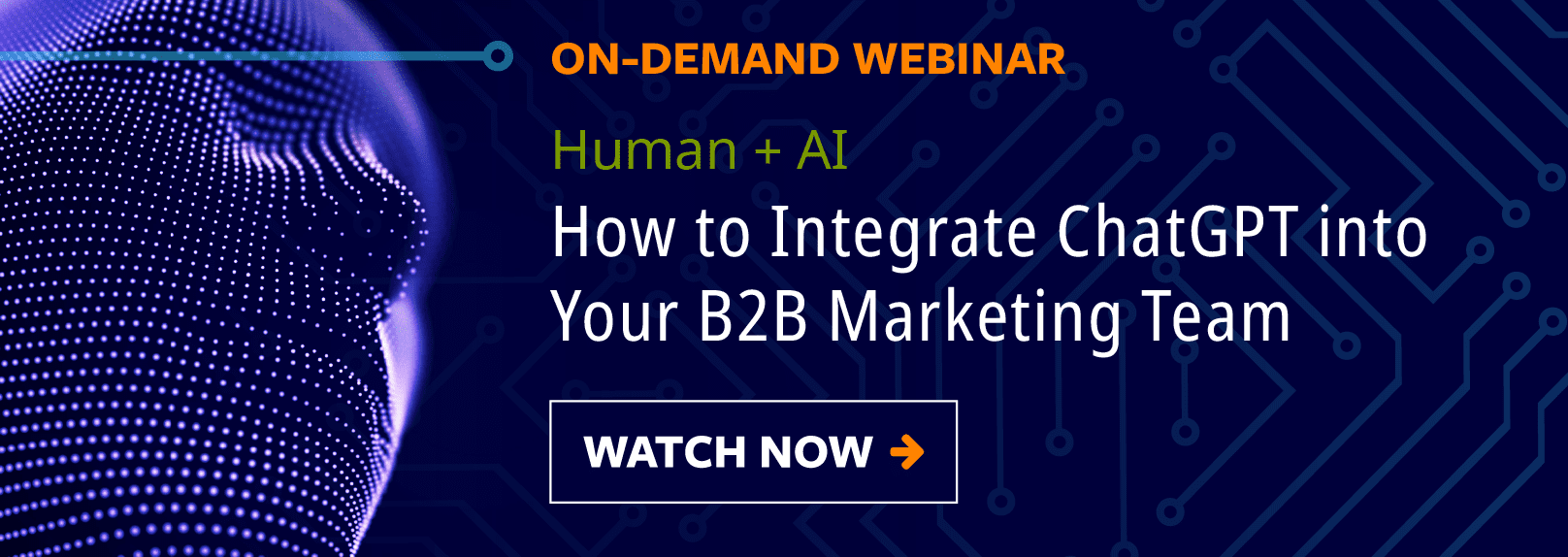
Does ChatGPT create search-engine optimized blog copy?
Once you start using the tool, it becomes easy to see how it can be used to scale your marketing efforts quickly, efficiently, and for very little cost. But like any good tool, the output is only as good as the input. And as we’ve learned, the copy that ChatGPT generates is NOT inherently optimized for SEO.
While ChatGPT can be an incredible asset to your content marketing team, no business should expect to fully replace their staff writers with AI. That’s because ChatGPT’s copy is not inherently optimized for SEO.
With ChatGPT, you’d still need a human writer to address the following areas.
1. ChatGPT does not utilize header structure
While you can ask ChatGPT to use headers to improve your copy, the necessary header structure to rank for SEO is often missing or not built correctly. We’re talking about the need to add header tags to the headers in your article, following current best practices.
2. ChatGPT does not utilize hyperlinks and appropriate sourcing
If you simply take an article from ChatGPT and publish it, you’ll be missing one of the most important elements of SEO content: thoughtful linking. We’re talking about links to your own copy as well as relevant and high-authority third-party sites.
You may be wondering - can’t I just ask ChatGPT to provide sources? Sure, you can ask. But be wary. We’ve found that sources are misleading or sometimes even completely wrong. It’s true. When writing an article about the benefits of a health supplement, ChatGPT provided a study source which was not only out dated, but completely unrelated to the content itself.
Which brings us to our next point: when writers research, it’s easy for them to bring in sourcing. And while ChatGPT may take some of the writing effort off your plate, it has been known to accidentally plagiarize and use incorrect information.
Always make sure you’ve thoroughly researched the output, especially if you work in finance, healthcare, legal, etc.
3. ChatGPT won’t optimize your image selection
Images are a critical part of your content strategy. And while you may be able to get copy produced with the tool, your images will have to come from another source. Unique images can help your content stand out and add authority.
4. ChatGPT won’t code in your page title and meta description
While the tool may help you come up with ideas for these areas, they still have to be added directly to your CMS. Same goes for your product/service CTAs.
5. ChatGPT doesn’t align your copy with a larger content strategy
Sure, you can use the tool to brainstorm ideas and get insights about what your customers care about. But what’s missing is that strategic tie back to your business goals. ChatGPT won’t be able to:
- Provide you with keyword metrics: This includes search volume, difficulty, and how your site and competitor’s sites rank. So while you may get some great ideas from the tool, what you won’t get is whether that’s actually a viable keyword for you to target your copy toward.
- Design a comprehensive content strategy: More copy is not necessarily a content strategy. You should have a data-backed and highly-researched plan (outside of ChatGPT) that is guiding the content you create. That starts with keyword research but also includes your pillar/cornerstone strategy, your lead generation strategy, your contact nurture strategy, and how all of those align with your social and email marketing strategies.
Will my ChatGPT content rank in Google?
It’s entirely possible that if you feed some prompts into ChatGPT and add it to your site, that your content will start to rank. But as SEO experts, we really cannot stress enough how wary you should be of that strategy.
Believe it or not, this isn’t the first time a new ‘hack’ has appeared which has made content optimization seem easier than ever.
Here are some examples:
The Panda Update Panic
It wasn’t too long ago that content marketers realized that the more keywords a page had, the more likely it was to rank. So, what did they do?
They went in and stuffed keywords everywhere. Into page titles, into meta descriptions, into alt tags.
Best of all? You could essentially clone an article, use different keywords, and then THAT page would start ranking, too!
So for about a year, content teams keyword stuffed everything. Then came the Panda Algorithm. Google began penalizing sites that were keyword stuffing and using duplicate content. So all that work, a year’s worth of effort, was essentially for naught in many cases.
Link Building Land
Then it was on to the next hack! All of a sudden, folks realized that the more links their site had, the more authority they were able to build.
Easy solution? Buy really cheap links online! And in no time, tons of traffic was pouring in.
Then came the Penguin Update. This update aimed at reducing the volume of sites using spammy links to rank.
But isn’t all traffic good traffic?
You may be thinking – but wait, these hacks actually WORKED for a while, so what’s the problem? Isn’t all traffic good traffic?
Wrong!
No one will really understand how Google’s Algorithm works. But what I can tell you is that sites that consistently lean into spammy tactics to get more traffic are consistently underperforming in the long run. The fits and starts make it difficult to follow and respond to new best practices.
For example, instead of focusing on net-new copy, sites that bought spammy links or keyword stuffed had to spend countless strategic hours cleaning up that mess.
Meanwhile, the slow-and-steady producers of great copy tended to rank - and stay ranking - because they met Google’s core requirement: be really, really helpful.
AI copy is the new baseline.
All SEOs who actually know what they’re talking about - ahem - are convinced that AI generated copy is “the new floor.”
Here’s an incredible article on that if you want to learn more. But essentially, what it means is that the bar for copy produced to rank has been consistently raised over the past 10 years.
The new floor to beat?
Your copy needs to be BETTER than what ChatGPT creates.

Like this Sparktoro article states, ChatGPT doesn’t understand emotion, it doesn’t understand vulnerability, it doesn’t understand nuance, it doesn’t - actually - understand the creative needs of your audience.
But you know who probably does? Your human copywriters!
Does Google penalize AI copy?
In an article published directly by Google, it clarified it stance on AI-generated copy.
”When it comes to automatically generated content, our guidance has been consistent for years. Using automation — including AI — to generate content with the primary purpose of manipulating ranking in search results is a violation of our spam policies.”
The article continues:
“This said, it’s important to recognize that not all use of automation, including AI generation, is spam. Automation has long been used to generate helpful content, such as sports scores, weather forecasts, and transcripts. AI has the ability to power new levels of expression and creativity, and to serve as a critical tool to help people create great content for the web. This is in line with how we’ve always thought about empowering people with new technologies.”
As you can see, the meaning behind this announcement is up for some debate. How much AI is too much AI? How can Google understand the intent?
But at the end of the day, simply using ChatGPT to bulk up your content efforts without an effective strategy to support its applications is not only a violation of Google’s policy, but may be the source of a potentially harmful site update in the future.
Does Google recognize AI-generated content?
If you’re just using ChatGPT to generate copy and then publishing it, you may be in for a rude awakening.
ChatGPT released a tool which helps to identify AI-generated copy. That means: no matter how much creative input you put into the tool, ChatGPT will recognize its own copy. It’s called the AI Text Classifier.
The classifier looks for signals in the copy (completely invisible to you and me!) to evaluate whether it thinks the copy was AI-generated.
All you need to do is pop in the copy you’ve written (or produced with AI) to determine how the tool classifies your content.

While there is no evidence that Google itself is crawling copy for AI-generated content, we should all reasonably assume Google has the power to implement a similar tool as part of its algorithm.
Google’s advice for people looking to use AI?
However, content is produced, those seeking success in Google Search should be looking to produce original, high-quality, people-first content demonstrating qualities experience, expertise, authoritativeness, and trust (E-E-A-T).
It’s safe to say that removing the human element completely is unlikely to demonstrate that people-first quality that’s so critical to Google’s ranking factors.
What are the business risks of using ChatGPT for content generation?
The risk to your traffic is not the only risk you’re taking when leaning on an AI-centric content strategy. In fact, there are a number of elements you need to keep in mind when using ChatGPT and other AI copy tools:
1. The quality and accuracy of your copy
While AI-generated content can be high-quality, there is still a risk that the content may not be accurate or up-to-date. We really can’t stress this enough. We’ve tried ChatGPT for a number of businesses including finance, medical, healthcare, manufacturing, and more. We’ve lost count of the number of times a bit of information was slightly incorrect or worse - sourced incorrectly when asked.
B2B businesses should spend ample time reviewing and editing the content generated by the tool to ensure that it meets their quality and accuracy standards.
DID YOU KNOW? ChatGPT only has data up to the year 2021. That means the tool may be more harmful than good for industries who rely on timely and relevant updates. Especially if they’re legal, medical, or newsworthy.
2. Your copy might be plagiarized
AI-generated content may unintentionally include content that is plagiarized from other sources. Yikes! B2B businesses should use tools to check for plagiarism and ensure that the content they publish is original.
Grammarly has a really great and free plagiarism checker!
3. Voice and tone
AI-generated content may not always reflect the voice and tone of the brand. B2B businesses should train the AI to generate content that aligns with their brand's messaging and style. When thinking about building a people-first ranking strategy, it’s imperative that you either help the AI understand your company voice or add it into the copy that’s generated.
4. Legal and ethical concerns
There may be legal and ethical concerns associated with using AI-generated content, especially if the content is used for advertising or marketing purposes. B2B businesses should consult with legal experts to ensure that their use of AI-generated content complies with relevant laws and regulations.
The tool is already strictly banned in many schools and colleges. Which leads many to wonder - if it’s not ethical to use there, should my business be any different?
In fact, Italy issued a temporary emergency decision which demanded that Open AI - the creators of ChatGPT, stop using the personal information of Italian citizens. And this raises significant privacy concerns - especially in European countries and those embracing GDPR.
5. Missing that human touch
While AI-generated content can save time and resources, it may lack the personal touch that human-written content can provide. B2B businesses should consider balancing the use of AI-generated content with human-written content to ensure a well-rounded content strategy.
The future of ChatGPT and B2B marketing
As a digital marketing agency, we’ve seen trends come and go for decades. While AI represents an exciting opportunity to combine the power of your human team with AI-centric tools, we highly recommend you proceed thoughtfully.
Want to connect with a marketing expert about how some of our clients are using ChatGPT to scale their marketing efforts - without removing the human element?
To learn more about optimizing for other AI engines, see our guide to generative engine optimization.


